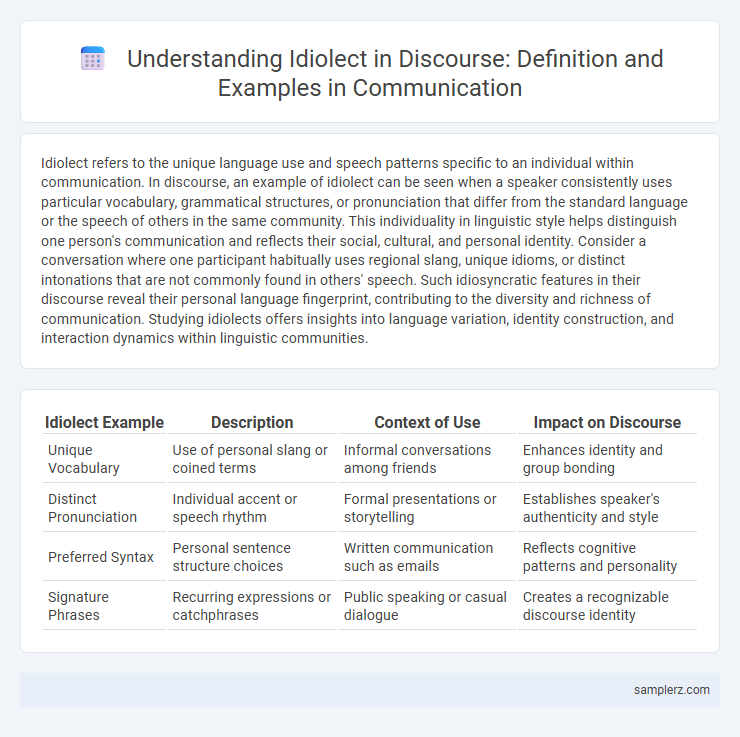Idiolect refers to the unique language use and speech patterns specific to an individual within communication. In discourse, an example of idiolect can be seen when a speaker consistently uses particular vocabulary, grammatical structures, or pronunciation that differ from the standard language or the speech of others in the same community. This individuality in linguistic style helps distinguish one person's communication and reflects their social, cultural, and personal identity. Consider a conversation where one participant habitually uses regional slang, unique idioms, or distinct intonations that are not commonly found in others' speech. Such idiosyncratic features in their discourse reveal their personal language fingerprint, contributing to the diversity and richness of communication. Studying idiolects offers insights into language variation, identity construction, and interaction dynamics within linguistic communities.
Table of Comparison
| Idiolect Example | Description | Context of Use | Impact on Discourse |
|---|---|---|---|
| Unique Vocabulary | Use of personal slang or coined terms | Informal conversations among friends | Enhances identity and group bonding |
| Distinct Pronunciation | Individual accent or speech rhythm | Formal presentations or storytelling | Establishes speaker's authenticity and style |
| Preferred Syntax | Personal sentence structure choices | Written communication such as emails | Reflects cognitive patterns and personality |
| Signature Phrases | Recurring expressions or catchphrases | Public speaking or casual dialogue | Creates a recognizable discourse identity |
Understanding Idiolect: A Key to Personal Communication
Idiolect refers to the unique language variations and speech patterns that an individual naturally adopts, influencing their personal communication style. Recognizing these distinct linguistic features in discourse enhances comprehension and fosters more effective interpersonal interactions. Understanding idiolect allows communicators to appreciate nuances in tone, vocabulary, and syntax, leading to deeper mutual understanding.
Defining Idiolect in Everyday Discourse
Idiolect refers to the unique language use of an individual, characterized by distinct vocabulary, grammar, and pronunciation patterns. In everyday discourse, idiolect manifests through personalized expressions and speech habits that differentiate one speaker from another, such as unique word choices or sentence structures. This personalized linguistic style influences communication by reflecting individual identity and social background within conversations.
Unique Speech Patterns: Real-Life Idiolect Examples
Unique speech patterns such as the specific vocabulary, intonation, and syntax used by a speaker exemplify idiolect in discourse, reflecting their individual linguistic footprint. For instance, a tech professional may consistently use jargon like "API" or "debug" uniquely combined with casual slang, distinguishing their communication style from others. These personalized linguistic habits enhance clarity in targeted conversations and demonstrate how idiolect shapes effective, context-specific communication.
How Idiolect Shapes Individual Communication Styles
Idiolect, the unique set of linguistic habits possessed by an individual, shapes distinct communication styles through personalized vocabulary, syntax, and pronunciation. For example, a person's frequent use of specific phrases or jargon in discourse reveals their background, social identity, and cognitive preferences. This personalized language pattern influences how messages are encoded and interpreted, making communication distinctly individual.
Influences on Idiolect: Culture, Region, and Experience
An individual's idiolect in discourse is deeply influenced by cultural background, regional dialects, and personal experiences, shaping unique vocabulary and expression patterns. For instance, someone raised in Southern United States might incorporate regional slang and phonetic variations, while cultural heritage introduces specialized terminology or idiomatic phrases. Lived experiences, such as profession or education, further customize language use, creating a distinctive communicative style within broader linguistic environments.
Idiolect vs. Dialect: Distinguishing Communication Differences
Idiolect refers to the unique language patterns and vocabulary used by an individual in communication, distinct from the broader dialect shared by a community. For example, a person might use specific slang, phrases, or pronunciation that reflect their personal experiences and environment, differentiating their speech from regional dialects. Understanding idiolect helps highlight individual variations within discourse, crucial for analyzing nuanced communication differences beyond standard dialect boundaries.
The Role of Idiolect in Social Interaction
Idiolect shapes social interaction by reflecting individual language patterns, including unique vocabulary, pronunciation, and grammar that distinguish one speaker from another. This personalized linguistic style influences how messages are interpreted and how social identities are constructed within discourse communities. Understanding idiolect enhances communication effectiveness by accounting for subtle variations that impact interpersonal relationships and group dynamics.
Idiolect in Written vs. Spoken Discourse
Idiolect manifests distinctly in written and spoken discourse through individual vocabulary choices, syntax, and stylistic preferences unique to a speaker or writer. In written communication, idiolect appears in personalized spelling, punctuation, and tone that reflect an individual's cognitive patterns and cultural influences. Spoken discourse idiolect reveals itself through pronunciation, intonation, and colloquialisms, offering insights into the speaker's social identity and emotional state.
Analyzing Famous Figures’ Idiolects in Public Discourse
Analyzing the idiolects of famous figures in public discourse reveals unique linguistic patterns that distinguish their communication styles. For example, Barack Obama's use of rhythm, repetition, and inclusive pronouns creates a persuasive and relatable idiolect that enhances his rhetorical impact. Similarly, Oprah Winfrey's idiolect features empathetic tone and narrative storytelling, fostering a strong emotional connection with her audience.
Harnessing Idiolect to Improve Communication Skills
Harnessing idiolect in discourse involves recognizing and adapting to the unique linguistic patterns and vocabulary an individual consistently uses, which enhances clarity and engagement in communication. By analyzing personal speech habits, speakers can refine their expression to better connect with diverse audiences and reduce misunderstandings. Effective use of idiolect enables tailored communication strategies, improving interpersonal interactions and overall communicative competence.

example of idiolect in discourse Infographic
 samplerz.com
samplerz.com